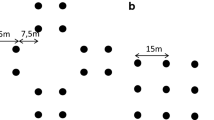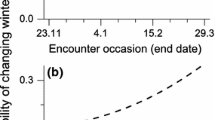Summary
A small population of meadow voles (Microtus pennsylvanicus) in a field enclosure was studied from August to February in Apalachin, New York, USA. Radiotelemetry provided direct measures of intraspecific spacing and social nesting through the fall-winter transition. Data on weather and predation were collected concurrently. A total of 32 voles were radiotracked during 6 tracking sessions, with an average of 17.3 voles (11 to 25 range) tracked per session (Figs. 1, 2a). Discrete social nesting “constellations” first occurred during October, primarily as a result of the formation of extended maternal families (Figs. 1, 2e). Recruitment of adult males and offspring into these early nesting groups was male biased. The average number of voles in these groupings varied from 3.2 (Jan; 3–4 range) to 7.0 (Oct; 4–10 range); but the average number of voles that slept together at any given time, the nesting “cluster,” remained steady at 2.4 (2–5 range) (Fig. 2e). During late December and early January under the protection of snow, many voles shifted their home areas and nesting affiliations with the result that non-lineage nesting constellations formed (Fig. 1, 3). The thermoregulatory benefits of huddling and the threat of predation appear to be important governors of movement, group formation and dispersion. The existence of an optimum group size produces and “Allee Effect” that may contribute importantly to population lows and multi-annual cycles.
Similar content being viewed by others
References
Alee WC, Emerson AE, Park O, Park T, Schmidt KP (1949) Principles of animal ecology. Saunders, Philadelphia, Pa
Chelkowska H (1978) Variations in numbers and social factors in a population of field voles. Acta Theriol 23:213–238
Christian JJ (1978) Neurobehavioral endocrine regulation of small mammal populations. In: Snyder DP (ed) Populations of small mammals under natural conditions. Pymatuning symposia in ecology, vol 5. University of Pittsburgh, Pittsburgh, Pa, pp 143–158
Christian JJ (1980) Endocrine factors in population regulation. In: Cohen M, Malpass R, Klein H (eds) Biosocial mechanisms of population regulation. Yale University Press, New Haven, Conn, pp 55–115
Finerty JP (1980) The population ecology of cycles in small mammals. Yale University Press, New Haven, Conn
Frank F (1957) The causality of microtine cycles in Germany. J-Wildl Manage 21:113–121
Fuller W, Stebbins L, Dyke G (1969) Overwintering of small mammals near Great Slave Lake, northern Canada. Arctic 22:34–55
Gebczynski M (1969) Social regulation of body temperature in the bank vole. Acta Theriol 14:427–440
Gebczynski M (1975) Heat economy and energy cost of growth in the bank vole during the first month of postnatal life. Acta Theriol 29:379–434
Gebczynski Z, Gebczynski M (1971) Insulating properties of the nest and social temperature regulation in Clethrionomys glareolus (Schreber). Ann Zool Fenn 8:104–108
Getz LL (1972) Social structure and aggressive behavior in a population of Microtus pennsylvanicus. J Mammal 53:310–317
Gorecki A (1968) Metabolic rate and energy budget in the bank vole. Acta Theriol 13:341–365
Hamilton, WJ Jr (1937) The biology of microtine cycles. J Agric Res 54:779–790
Hansson LH, Grodzinski W (1970) Bioenergetic parameters of the field vole, Microtus agrestis L. Oikos 21:76–82
Hayne D (1949) Calculation of size of home range. J Mammal 30:1–18
Iverson S, Turner B (1969) Under-snow shelter for small mammal trapping. J Wildl Manage 33:722–723
Jannett FJ Jr (1978) The density-dependent formation of extended maternal families of the montane vole, Microtus montanus nanus. Behav Ecol Sociobiol 3:245–263
Krebs CJ (1978) A review of the Chitty hypothesis of population regulation. Can J Zool 56:2463–2480
Krebs CJ, Myers JH (1974) Population cycles in small mammals. Adv Ecol Res 8:267–399
Lidicker WZ Jr (1975) The role of dispersal in the demography of small mammals. In: Golley FB, Petrusewicz K, Ryszkowski L (eds) Small mammals: their productivity and population dynamics. Cambridge University Press, England, pp 103–128
MacLean SF, Fitzgerald BM, Pitelka FA (1974) Population cycles in Arctic lemmings: winter reproduction and predation by weasels. Arc Alp Res 6:1–112
Madison D (1978) Movement indicators of reproductive events among female meadow voles. J Mammal 59:835–843
Madison D (1980a) Space use and social structure in meadow voles, Microtus pennsylvanicus. Behav Ecol Sociobiol 7:65–71
Madison D (1980b) An integrated view of the social behavior of Microtus pennsylvanicus. Biologist 62:20–33
Madison D (1984a) Group nesting and its ecological and evolutionary significance in overwintering microtine rodents. In: Merritt J (ed) Proceedings of International Colloquium: Winter Ecology of Small Mammals. Carnegie Mus Nat Hist, Spec Publ (in press)
Madison D (1984b) Activity rhythms and spacing. In: Tamarin R (ed) Biology of New World Microtus. Am Soc Mammal Spec Publ (in press)
Pruitt WO Jr (1957) Observations on the bioclimate of some taiga mammals. Arctic 10:131–138
Trojan P, Wojciechowska B (1968) The effect of huddling on the resting metabolism of the European common vole, Microtus arvalis (Pall). Bull Acad Pol Sci, Cl II, 16:107–109
Webster AB, Brooks RJ (1981a) Daily movements and short activity periods of free-ranging meadow voles, Microtus pennsylvanicus. Oikos 37:80–87
Webster AB, Brooks RJ (1981b) Social behavior of Microtus pennsylvanicus in relation to seasonal changes in demography. J Mammal 62:738–751
West SD (1977) Midwinter aggregation in the northern redbacked vole, Clethrionomys rutilus. Can J Zool 55:1404–1409
West SD, Dublin HT (1984) Behavioral strategies of small mammals under winter conditions: solitary or social. In: Merritt J (ed) Proceedings of International Colloquium: Winter Ecology of Small Mammals. Carnegie Mus Nat Hist, Spec Publ (in press)
Wiegert RG (1961) Respiratory energy loss and activity patterns in the meadow vole, Microtus pennsylvanicus pennsylvanicus. Ecology 42:245–253
Wolff JO, Lidicker WZ Jr (1981) Communal winter nesting and food sharing in taiga voles. Behav Ecol Sociobiol 9:237–240
Author information
Authors and Affiliations
Rights and permissions
About this article
Cite this article
Madison, D.M., FitzGerald, R.W. & McShea, W.J. Dynamics of social nesting in overwintering meadow voles (Microtus pennsylvanicus): possible consequences for population cycling. Behav Ecol Sociobiol 15, 9–17 (1984). https://doi.org/10.1007/BF00310209
Received:
Accepted:
Issue Date:
DOI: https://doi.org/10.1007/BF00310209




